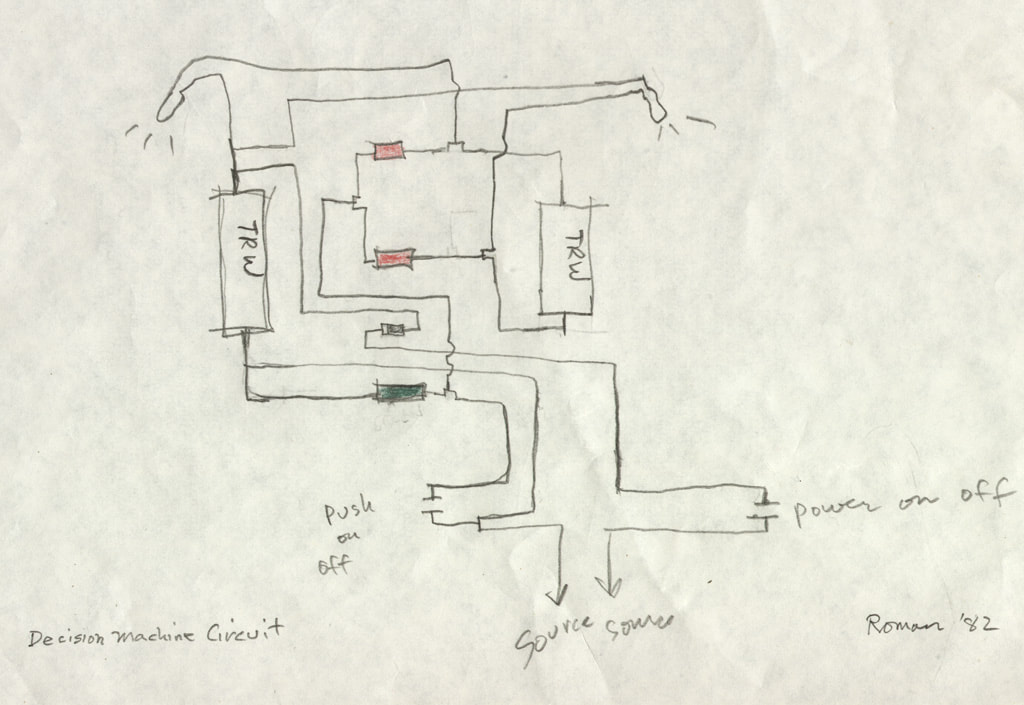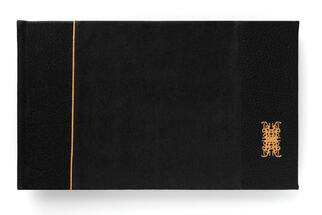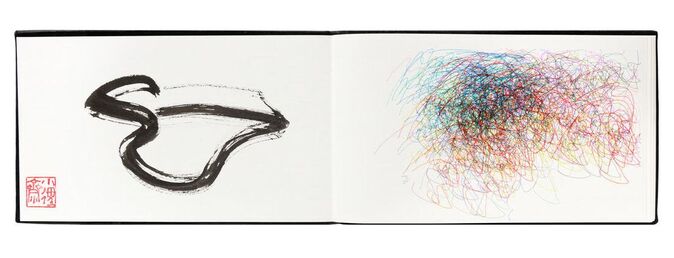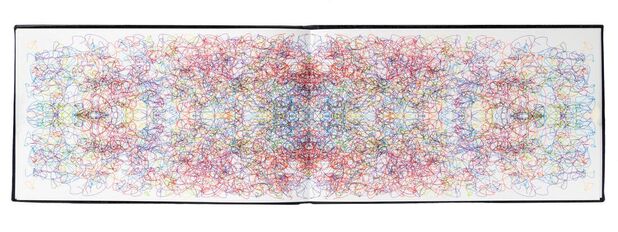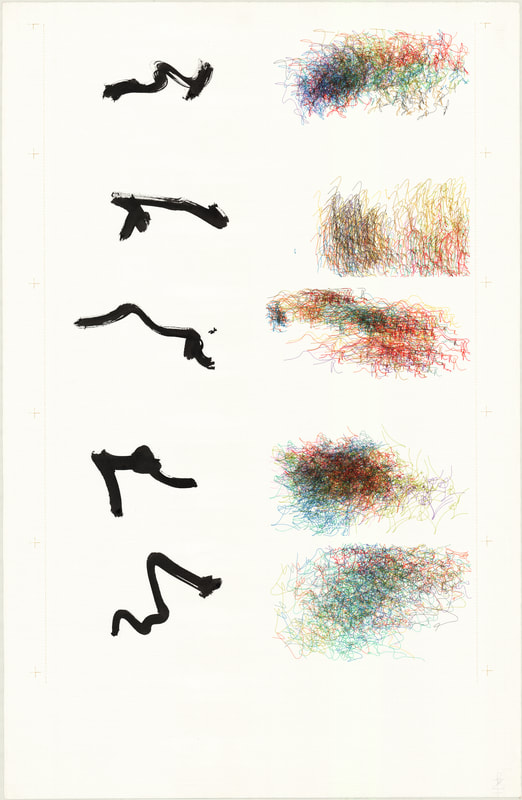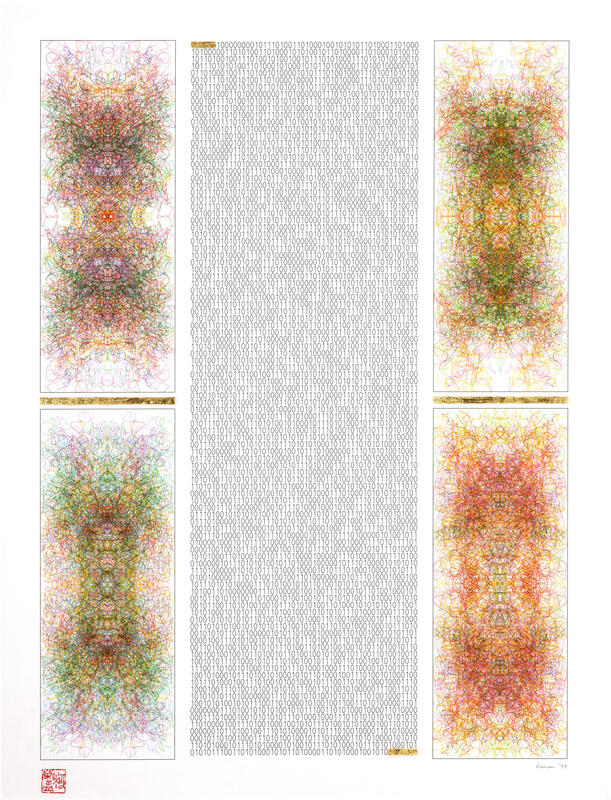Art, Logic, and the Decision Problem
I do not approach my work as a mathematician. I create my algorithms as an artist with certain experienced ideas about how to create my art. And this ultimately leads me to the nature of the computing machine as well.
|
Verostko
|
Verostko’s interest in art and technology, which in the early 1960s had been nurtured by the art critic and curator Stephen Joy, was cemented when he moved to Minnesota in August 1968. The metro area included the international headquarters for Control Data, Honeywell, and Cray Supercomputer. In addition, UNIVAC, along with others specializing in electronic typesetting, digital animation, and medical graphics, made the Twin Cities an attractive computer center in the U.S.
Between 1969 and 1971, Verostko served as a humanities consultant at Tetra Corporation, an electronics startup company, where he could visit, observe, interact with engineers, and learn about the industry. That experience introduced him to circuits and led him several years later to construct a series of Decision Machines in honor of Norbert Weiner, the mathematician who established the field of cybernetics. These interactive works were the first of Verostko’s projects to pay homage to pioneers who contributed to the twentieth-century information revolution.
The development of electronic circuit logic and the human control of digital machines has a very deep history that reaches back to early counting systems and Aristotelian logic. As a student of philosophy, Verostko was seduced by Aristotle’s principle of contradiction: “It is impossible for any being to possess a quality and at the same time not to possess it,” (Metaphysics, Book III). Many years later, he found that Boolean operators—the words “AND,” “OR,” and “NOT” that form the basis of mathematical sets and database logic—embodied the same ancient principle of contradiction. This then led him to read George Boole’s 1854 book The Laws of Thought and, eventually, to create a limited-edition book honoring his work. The final homage, to Alan Turing and his Universal Turing Machine, coincided in 1995 with Verostko’s assistance in coining the term “algorist” to define the artists who were making art by writing their own code. Verostko’s extensive research and writing on the topic ranges from the ninth-century mathematician Muhammad al-Khwarizmi, from whose name derives the word “algorithm,” to a host of Verostko’s contemporary “computer pioneers.” In this regard, Verostko has established an essential understanding of a historical continuum of which he is a part.
Between 1969 and 1971, Verostko served as a humanities consultant at Tetra Corporation, an electronics startup company, where he could visit, observe, interact with engineers, and learn about the industry. That experience introduced him to circuits and led him several years later to construct a series of Decision Machines in honor of Norbert Weiner, the mathematician who established the field of cybernetics. These interactive works were the first of Verostko’s projects to pay homage to pioneers who contributed to the twentieth-century information revolution.
The development of electronic circuit logic and the human control of digital machines has a very deep history that reaches back to early counting systems and Aristotelian logic. As a student of philosophy, Verostko was seduced by Aristotle’s principle of contradiction: “It is impossible for any being to possess a quality and at the same time not to possess it,” (Metaphysics, Book III). Many years later, he found that Boolean operators—the words “AND,” “OR,” and “NOT” that form the basis of mathematical sets and database logic—embodied the same ancient principle of contradiction. This then led him to read George Boole’s 1854 book The Laws of Thought and, eventually, to create a limited-edition book honoring his work. The final homage, to Alan Turing and his Universal Turing Machine, coincided in 1995 with Verostko’s assistance in coining the term “algorist” to define the artists who were making art by writing their own code. Verostko’s extensive research and writing on the topic ranges from the ninth-century mathematician Muhammad al-Khwarizmi, from whose name derives the word “algorithm,” to a host of Verostko’s contemporary “computer pioneers.” In this regard, Verostko has established an essential understanding of a historical continuum of which he is a part.
Circuit Mind, Tetra Corporation Memorial
Circuit Mind, Tetra Corporation Memorial, 1971, circuit board mounted in wood frame on wood base, 8 1/2 x 5 1/4 x 15 1/2 in.
In 1969 a new friend, Dr. Piero Morawetz, had undertaken to invest all his assets and energy in founding the Tetra Corporation in Minneapolis. Both he and his wife were active in the Minneapolis art world and we shared a mutual interest in advancing the role of art and culture in emerging technologies. Piero suggested that we try an informal collaboration whereby I would help nurture a relationship with art and culture with the Tetra Corporation as it grew. He invited me to be a humanistic adviser to the corporation. As I recall, Tetra had an interest in information display networks that would later replace the manual signage in places like airports. Around 1974 Tetra failed and investors lost everything. Even so, we all learned a lot through that experience that strengthened our professional life as we also grew. I had saved one of Tetra’s circuit boards and mounted it as a piece of sculpture in 1970. Years later, as my memory of Tetra, I labeled it as my “Tetra Corporation Memorial.”
During that period, I had access to the working labs at Tetra where I could visit, observe, interact with engineers, and learn about the industry. I learned a bit about circuits at Tetra. That experience led me later to learn enough about circuits to construct my electronic “Decision Machines” in honor of Norbert Wiener. There were circuit diagrams available for students and I found one who helped me build the gating circuit for a decision machine. I acquired the soldering tools, transistors, and other parts at a popular electronics store on the North side of Minneapolis. By the 1980s, with an IBM PC and some experience programming, my studio had become an electronic studio. Looking back now, I believe my experience with my Psalms in Sound and Image (1966–67) were the first step towards programming my art ideas in a coded format—from art ideas in mind to art ideas in code.
During that period, I had access to the working labs at Tetra where I could visit, observe, interact with engineers, and learn about the industry. I learned a bit about circuits at Tetra. That experience led me later to learn enough about circuits to construct my electronic “Decision Machines” in honor of Norbert Wiener. There were circuit diagrams available for students and I found one who helped me build the gating circuit for a decision machine. I acquired the soldering tools, transistors, and other parts at a popular electronics store on the North side of Minneapolis. By the 1980s, with an IBM PC and some experience programming, my studio had become an electronic studio. Looking back now, I believe my experience with my Psalms in Sound and Image (1966–67) were the first step towards programming my art ideas in a coded format—from art ideas in mind to art ideas in code.
|
Verostko
|
Decision Machine Suite
|
The White House, Yea or Ney?, c. 1982–85, wood salvaged from the 1949–52 White House renovation (preserved by Alice Wagstaff’s uncle, Henry Barr), diodes, transistors, capacitors, neon lamps, a “single pole” in-put switch, and a push button decision switch. Power supply is 120 AC household current. Photo: Rik Sferra
|
The electronic machines above pay homage to Norbert Wiener (1894–1964), the scientist and humanist who coined the word “cybernetics” and is considered to be the father of the study of the guidance and control systems designed for machines.
The Decision Machines provide a playful electronic trigger that yields a random “one bit” of information that alters the flow of current, symbolizing “yes” or “no.” We can never know (or control) which path it will elect. In this regard, it is a tribute to Weiner who observed in his book The Human Use of Human Beings: Cybernetics and Society (1950) that “the functional part of physics cannot escape considering uncertainty and the contingency of events.”
These specialized machines symbolize several of the most difficult decisions humans have to make. Reasoning works when we have sufficient information and the time to make an intelligent decision. But what of those moments when we cannot make up our mind, one way or the other? Should I vote yes or no? Should I buy or sell? Is this action morally right or wrong? In such instances these machines work like a flip of the coin: press a button and one of two lamps remain lit with a decision. At the moment that a user presses the machine’s decision button, the circuit elects only one of two possible paths. The circuit “decision” cannot be predetermined by the user, so each machine is an excellent randomizer.
Playful desktop “decision machines,” along with small handheld calculators and other electronics, were popular in the late 1970s and early 1980s. In 1979 Verostko came upon a circuit schematic for a “decision maker” and made his first generic Decision Machine in 1979 as a Christmas gift. The others on display here date between 1983 and 1985.
The Decision Machines provide a playful electronic trigger that yields a random “one bit” of information that alters the flow of current, symbolizing “yes” or “no.” We can never know (or control) which path it will elect. In this regard, it is a tribute to Weiner who observed in his book The Human Use of Human Beings: Cybernetics and Society (1950) that “the functional part of physics cannot escape considering uncertainty and the contingency of events.”
These specialized machines symbolize several of the most difficult decisions humans have to make. Reasoning works when we have sufficient information and the time to make an intelligent decision. But what of those moments when we cannot make up our mind, one way or the other? Should I vote yes or no? Should I buy or sell? Is this action morally right or wrong? In such instances these machines work like a flip of the coin: press a button and one of two lamps remain lit with a decision. At the moment that a user presses the machine’s decision button, the circuit elects only one of two possible paths. The circuit “decision” cannot be predetermined by the user, so each machine is an excellent randomizer.
Playful desktop “decision machines,” along with small handheld calculators and other electronics, were popular in the late 1970s and early 1980s. In 1979 Verostko came upon a circuit schematic for a “decision maker” and made his first generic Decision Machine in 1979 as a Christmas gift. The others on display here date between 1983 and 1985.
The circuit provides enough current to keep two lamps blinking. At the moment when a user presses the “push- button” switch a change in current allows only one lamp to remain blinking. The side with the blinking light at that moment identifies the “decision” side.
Derivation of the Laws
Computer-generated illustrations by Verostko illuminate Derivation of the Laws of the Symbols of Logic from the Laws of the Operations of the Human Mind, a chapter reprinted from George Boole’s seminal text The Laws of Thought (1854). Boole (1815–1864), who is considered the father of symbolic logic, developed ways of expressing logical processes using algebraic symbols. His contributions underlie the development of switching theory essential for computing circuitry.
Verostko used his original software to illustrate this book as a tribute to the nineteenth-century English mathematician. The algorithms operate on the principles outlined in Boole’s Laws, exemplifying a profound kinship between art and science. The limited edition, bound in leather, was pulled by hand at the St. Sebastian Press in Minneapolis in 1990.
Verostko used his original software to illustrate this book as a tribute to the nineteenth-century English mathematician. The algorithms operate on the principles outlined in Boole’s Laws, exemplifying a profound kinship between art and science. The limited edition, bound in leather, was pulled by hand at the St. Sebastian Press in Minneapolis in 1990.
Frontispieces & End Pieces
For this project the frontispieces and end pieces were all generated from the same “parent code,” yielding unique forms for each book in the edition. Each “one of a kind” drawing was drawn or brushed, stroke for stroke, with a pen plotter driven by the artist's software (parent code). Two families of form, 125 originals in each, introduced a new procedure in what could be understood as “post-mechanical reproduction.” The 1990 edition may be the first instance where an algorithmic improvisational series of original drawings was created for a bound limited-edition artist book.
All algorithmic procedures and parameters for the frontispieces and end pieces were created and monitored by Verostko in his studio. For each brushstroke, an interactive brushing routine paused the procedure and requested a brush for the plotter’s drawing arm. For this project, Alice Wagstaff, Verostko's wife, assisted in monitoring the pen plotters and inks. She also became expert at loading brushes for the drawing arm.
For this project the frontispieces and end pieces were all generated from the same “parent code,” yielding unique forms for each book in the edition. Each “one of a kind” drawing was drawn or brushed, stroke for stroke, with a pen plotter driven by the artist's software (parent code). Two families of form, 125 originals in each, introduced a new procedure in what could be understood as “post-mechanical reproduction.” The 1990 edition may be the first instance where an algorithmic improvisational series of original drawings was created for a bound limited-edition artist book.
All algorithmic procedures and parameters for the frontispieces and end pieces were created and monitored by Verostko in his studio. For each brushstroke, an interactive brushing routine paused the procedure and requested a brush for the plotter’s drawing arm. For this project, Alice Wagstaff, Verostko's wife, assisted in monitoring the pen plotters and inks. She also became expert at loading brushes for the drawing arm.
|
Derivation of the Laws of the Symbols of Logic from the Laws of the Operations of the Human Mind : An Excerpt from the Writings of George Boole, computer illustration by Roman Verostko, preface by Roger F. Malina, 1990, limited letterpress edition artist book with two original works tipped in. Edition #13/20 with Moroccan leather, collection of the Minneapolis College of Art and Design. Photo: Rik Sferra
|
Frontispiece, Edition #82/100, Anne and Michael Spalter Digital Art Collection.
Frontispiece, Edition #13/20, collection of the Minneapolis College of Art and Design.
Photo: Rik Sferra
Photo: Rik Sferra
End Piece, Edition #82/100, Anne and Michael Spalter Digital Art Collection.
End Piece, Edition #13/20, collection of the Minneapolis College of Art and Design. Photo: Rik Sferra
Derivation of the Laws (frontispiece proof sheet), 1990, pen, ink, and brush plotter drawing, 24 1/4 x 37 in.
Diagram of coded coordinates in Derivation of the Laws, Edition #82, Anne and Michael Spalter Digital Art Collection.
The ten coordinates controlling the brushstroke on the left are identified in the ten golden orbs shown in the diagram on the right. The smaller strokes present variations and distributions based on the brushstroke curve.
The ten coordinates controlling the brushstroke on the left are identified in the ten golden orbs shown in the diagram on the right. The smaller strokes present variations and distributions based on the brushstroke curve.
Printing & Typography: Michael Tomaszewski
While the front and end pieces were original one-of-a-kind works, the internal color illustrations accompanying the text were reproductions printed in four colors using four zinc line-cut plates. Verostko created algorithmic pen and ink drawings for these interior illustrations. Using the master code, he cloned each color in a separate drawing using black ink for each color. From these drawings, four line-cut zinc plates were made for each color illustration. With a Vandercook “Vandy” proof press, Tomaszewski printed all four colors with a wet impression in the same run. Tomaszewski set the text in Gill Sans that he had cast at M&H Type of San Francisco. The same type setting, layout, and plates were used for the paperback black-and-gold reproduction edition.
Binding: Michael Norman
Leather bindings by Norman included 100 regular; 20 deluxe Moroccan with gold imprint; and 5 artist proofs (never completed). The Pathway Studio Seal was carved by Wang Dongling, a master calligrapher from Hangzhou, People’s Republic of China.
While the front and end pieces were original one-of-a-kind works, the internal color illustrations accompanying the text were reproductions printed in four colors using four zinc line-cut plates. Verostko created algorithmic pen and ink drawings for these interior illustrations. Using the master code, he cloned each color in a separate drawing using black ink for each color. From these drawings, four line-cut zinc plates were made for each color illustration. With a Vandercook “Vandy” proof press, Tomaszewski printed all four colors with a wet impression in the same run. Tomaszewski set the text in Gill Sans that he had cast at M&H Type of San Francisco. The same type setting, layout, and plates were used for the paperback black-and-gold reproduction edition.
Binding: Michael Norman
Leather bindings by Norman included 100 regular; 20 deluxe Moroccan with gold imprint; and 5 artist proofs (never completed). The Pathway Studio Seal was carved by Wang Dongling, a master calligrapher from Hangzhou, People’s Republic of China.
Epigenesis: The Growth of Form
In the mid 1990s, Verostko was commissioned to create a public art project for the Owens Science Hall as part of the new Frey Science and Engineering Center on the St. Paul campus of the University of St. Thomas. It consists of eleven code generated drawings, each 3-by-6 ft. Both pen and ink strokes and brushstrokes were executed with a multi-pen plotter guided by Verostko’s original drawing instructions. Installed in September of 1997, the eleven units are framed with oak paneling crafted by Don Zwernik. The finished project, measuring 40-by-9 ft., occupies two alcoves, and wraps around a central pilaster.
Installation view of Epigenesis: The Growth of Form. Frey Science and Engineering Center, University of St. Thomas - St. Paul, Minnesota.
The brushstrokes that mirror each other identify the initiating coordinates. Thousands of lines, derived from this initiating shape, cluster and mirror themselves throughout the eleven panels. In effect, the mural displays the growth of form and, by analogy, to the biological process epigenesis. The smaller calligraphic strokes were code-generated with procedures drawing on the same controllers used for the brushstrokes. A “self-similarity” permeates the form varieties as all share the same parent code.
Epigenesis: Growth of Form (model), 1996, pen and ink plotter drawings with hand-applied gold leaf. Photo: Rik Sferra.
This preliminary one-sixth scale model, a work of art in its own right, served as the first stage of the project. One model was included in the 1997 SIGGRAPH exhibition Ongoings: The Fine Arts Gallery in Los Angeles. A second version of this model is permanently on display at the downtown Minneapolis campus of the University of St. Thomas (second floor, main overpass).
Illuminated Universal Turing Machines
Manchester Illuminated Universal Turing Machine #23, 1998, pen and ink plotter drawing with hand-applied gold leaf, 30 x 22 in.
What is a Turing Machine?
A Turing Machine is a not a real machine, it is a theoretical idea that plays an important role in the foundations of mathematics and computer science. Turing Machines are useful for studying algorithms; they provide a language for describing certain abstract concepts in a precise way.
The English mathematician Alan Turing (1912–1954) outlined this abstract, mathematical model of computability in his 1936 paper “On Computable Numbers” in order to answer a mathematical problem called the “decision problem”: whether there is a systematic way to find a solution to every mathematical problem. He showed that no Turing Machine, and hence no computational procedure at all, could solve the Entscheidungsproblem or “decision problem.”
What is a Universal Turing Machine?
A Universal Turing Machine (UTM) is similar in many respects to a modern computer that can execute stored programs. It’s a Turing Machine that mimics other Turing Machines.
A UTM takes as input the description number of another Turing Machine, and produces as output the same sequence of 0's and 1';s as that machine, by executing the instructions in the description number one at a time.
A Turing Machine is a not a real machine, it is a theoretical idea that plays an important role in the foundations of mathematics and computer science. Turing Machines are useful for studying algorithms; they provide a language for describing certain abstract concepts in a precise way.
The English mathematician Alan Turing (1912–1954) outlined this abstract, mathematical model of computability in his 1936 paper “On Computable Numbers” in order to answer a mathematical problem called the “decision problem”: whether there is a systematic way to find a solution to every mathematical problem. He showed that no Turing Machine, and hence no computational procedure at all, could solve the Entscheidungsproblem or “decision problem.”
What is a Universal Turing Machine?
A Universal Turing Machine (UTM) is similar in many respects to a modern computer that can execute stored programs. It’s a Turing Machine that mimics other Turing Machines.
A UTM takes as input the description number of another Turing Machine, and produces as output the same sequence of 0's and 1';s as that machine, by executing the instructions in the description number one at a time.
Illuminated Universal Turing Machine, 1995, pen and ink plotter drawing with hand-applied gold leaf, 30 x 40 in., Photo: Rik Sferra
Rationale for this Artwork
For Verostko, the binary code of a UTM algorithm is like a medieval biblical text: it radiates an aura of authority even though difficult to comprehend. In the tradition of manuscript illumination Verostko wrote algorithms to illuminate the code for a Universal Turing Machine (UTM) and to celebrate its impact on our culture. These illuminations are works of art and not exercises in computer science. They are intended to mark the significance of the UTM in shaping cultural change. As medieval Latin transcended the vernacular and was universally understood by those schooled in Latin, so too are Verostko’s algorithmic codes speaking a universal tongue that can be understood by those schooled in computer science.
The Manchester Illuminated Universal Turing Machine Project
To pay homage to Alan Turing’s role in the development of computers, Verostko created a series of fifteen original drawings for an exhibition at the University of Manchester on the occasion of the Ninth International Symposium on Electronic Art (ISEA 1998). The year 1998 marked the 50th anniversary of the Manchester Small-Scale Experimental Machine (SSEM), nicknamed “Baby,” which was the world’s first stored-program computer. The designers were Professor Frederic Williams, Tom Kilburn, and Geoff Tootill at the University of Manchester.
For Verostko, the binary code of a UTM algorithm is like a medieval biblical text: it radiates an aura of authority even though difficult to comprehend. In the tradition of manuscript illumination Verostko wrote algorithms to illuminate the code for a Universal Turing Machine (UTM) and to celebrate its impact on our culture. These illuminations are works of art and not exercises in computer science. They are intended to mark the significance of the UTM in shaping cultural change. As medieval Latin transcended the vernacular and was universally understood by those schooled in Latin, so too are Verostko’s algorithmic codes speaking a universal tongue that can be understood by those schooled in computer science.
The Manchester Illuminated Universal Turing Machine Project
To pay homage to Alan Turing’s role in the development of computers, Verostko created a series of fifteen original drawings for an exhibition at the University of Manchester on the occasion of the Ninth International Symposium on Electronic Art (ISEA 1998). The year 1998 marked the 50th anniversary of the Manchester Small-Scale Experimental Machine (SSEM), nicknamed “Baby,” which was the world’s first stored-program computer. The designers were Professor Frederic Williams, Tom Kilburn, and Geoff Tootill at the University of Manchester.




